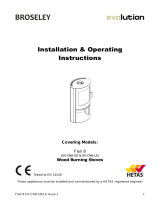16
4 OPERATION INSTRUCTIONS
WARNING: READ THE OWNER’S MANUAL CAREFULLY BEFORE USING YOUR FIREPLACE INSERT.
The FLAIR is not intended to serve as a primary source of heat; the home where the FLAIR fireplace insert will
be installed must have a primary source of heat. SUPREME is not responsible for heating costs related to other
sources of heat.
4.1 Fuel
The FLAIR is designed to burn natural wood only. Higher efficiencies and lower emissions generally result when
burning air dried seasoned hardwoods (moisture content below 20%), as compared to softwoods or to green or
freshly cut hardwoods. The following are a few signs indicating that firewood is sufficiently dry for use: (a) cracks
on the ends and surface of the logs, (b) lighter in weight, and (c) color (yellow/grey). It is recommended to use a
moisture meter with pin sensors for determining accurately the moisture content of firewood (read manufacturer’s
instruction manual before operating). The optimum log length is between 16 to 22 inches, preferably split in
halves or quarters and left to dry under a cover or away from external elements for a minimum of one year prior
to use. Use good quality dry cordwood only. DO NOT burn garbage, lawn clipping, yard waste, materials
containing rubber (including tires), materials containing plastic, waste petroleum products, paints, paint thinners,
asphalt products, materials containing asbestos, construction debris, demolition debris, railroad ties, pressure-
treated wood, manure, animal remains, coal, salt water driftwood or other previously salt water saturated
materials, unseasoned wood, paper products, cardboard, plywood, particle boards, or other foreign materials in
this product. The prohibition against burning these materials does not prohibit the use of fire starters made from
paper, cardboard, saw dust, wax and similar substances for the purpose of starting a fire in an affected wood
heater. Burning these materials may result in release of toxic fumes or render the heater ineffective and cause
smoke. Do not over fire the FLAIR fireplace insert. Over firing will damage the fireplace, is hazardous and will
void the warranty. NOTE: Gas logs cannot be installed in the FLAIR fireplace insert.
WARNING: Never use gasoline, gasoline-type lantern fuel, kerosene, charcoal lighter fluid, or similar
liquids to start or “freshen up” a fire in this unit. Keep all such liquids well away from the fireplace insert
while it is in use.
Ecological or compressed logs containing chemical additives are not tested and approved to be used with the
FLAIR. Using them will overheat and damage the fireplace and void the warranty. Ecological or compressed logs
that are 100% wood and contain no other additives can be safely used in the FLAIR. Never use more than three
of these logs at a time. Using more is not only dangerous but will damage the fireplace and void the warranty.
Follow the ecological log manufacturer’s safety guidelines and recommendations and be sure that they are
intended for use in fireplaces. Reload only once the previous load of wood has been consumed and only embers
remain.
WARNING: Do not keep the door open while the fireplace is in operation.
4.2 First Fires
For the first 3 fires, burn a maximum of 3 logs at the medium to low burn rate (refer to Section 4.3) to allow for
proper conditioning of the unit. Due to oil residues and the curing of the paint of the fireplace, it is normal to smell
an odor for the first fires of the FLAIR. Open a window or a door near the fireplace insert to ventilate the house
during the first fires. Oil residues may cause light smoking.
4.3 Operating the Combustion Air Control
The burn rate and the heat output are related to the amount of air entering into the firebox. The combustion air
control of the FLAIR has two components: the Activator and the Burn Rate Selector. When starting the fire or
























